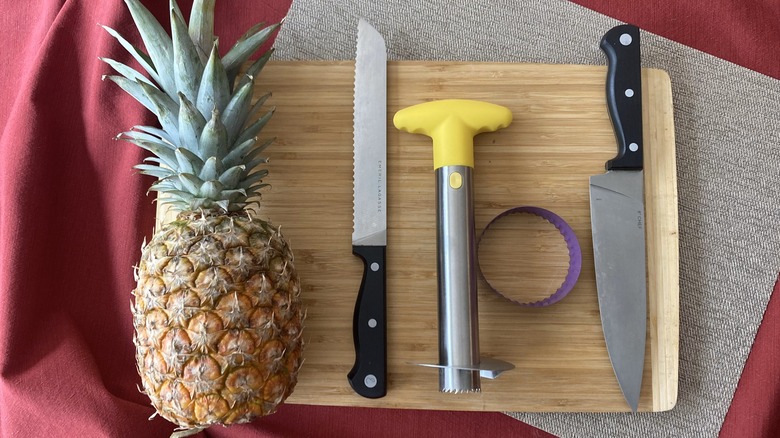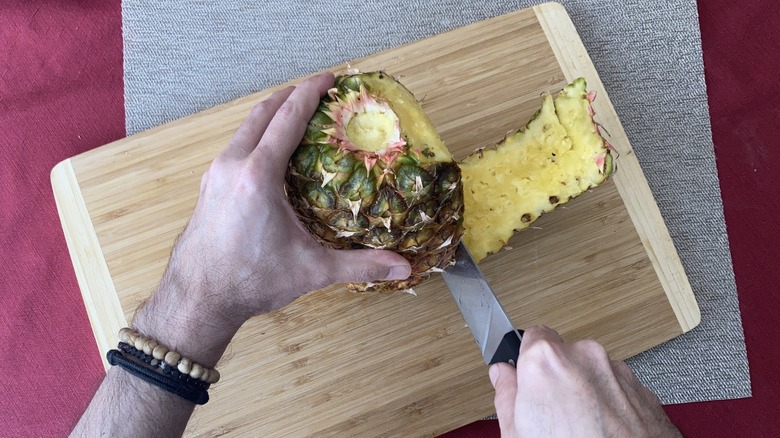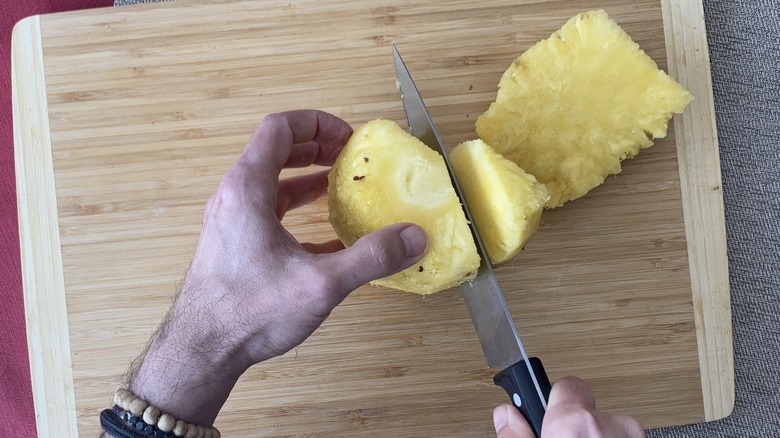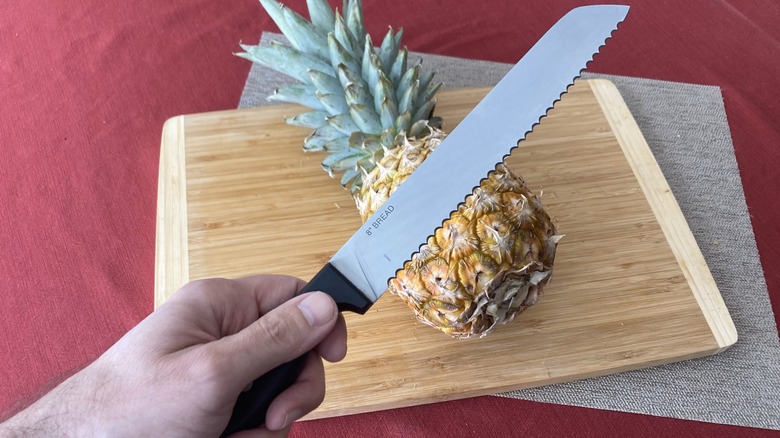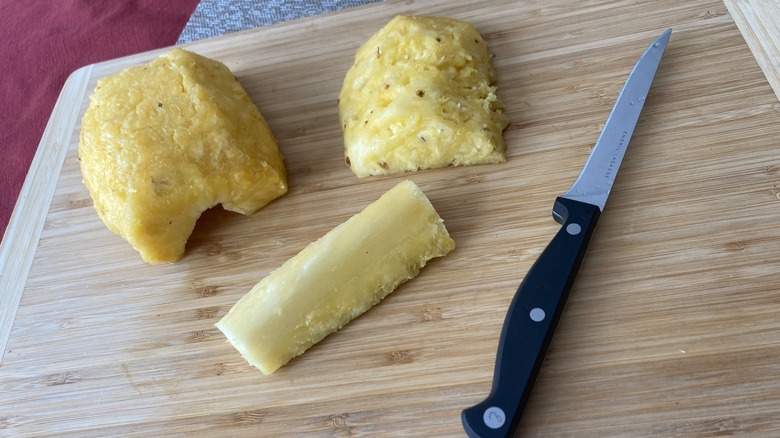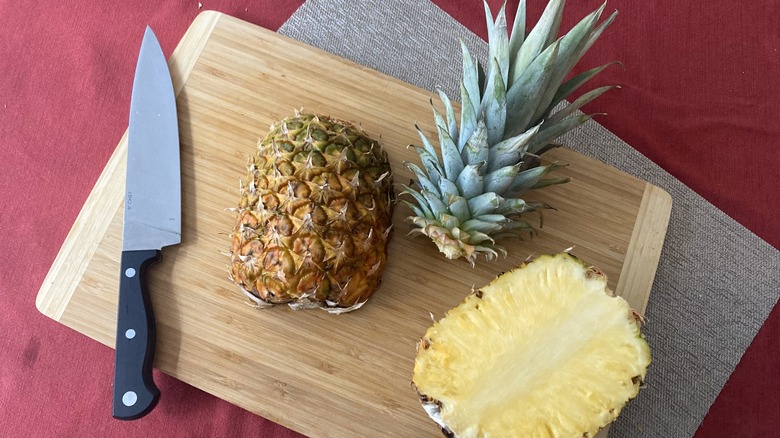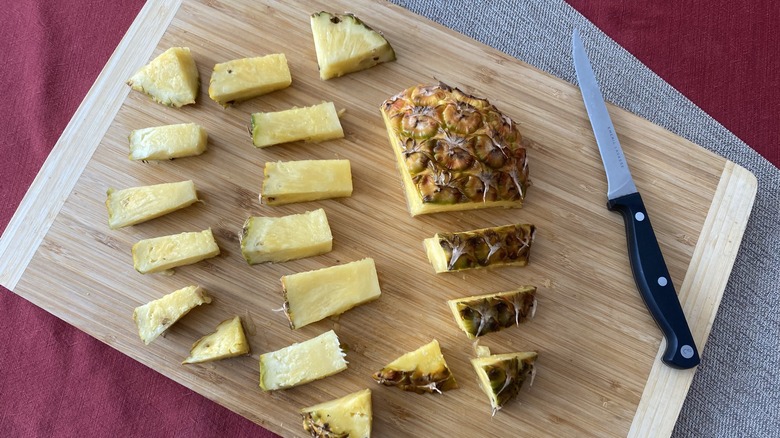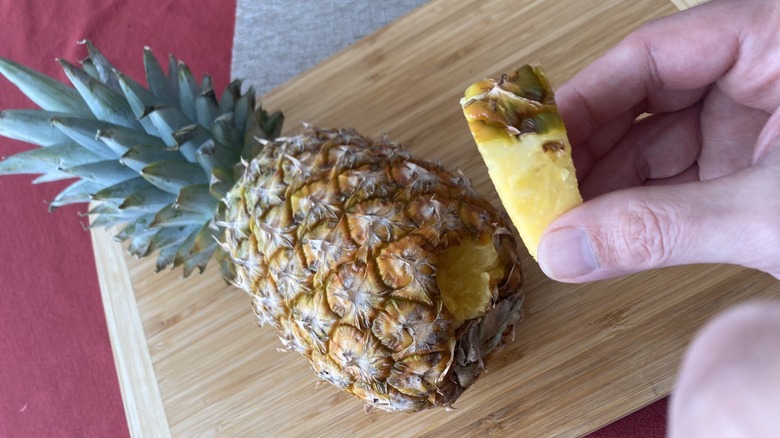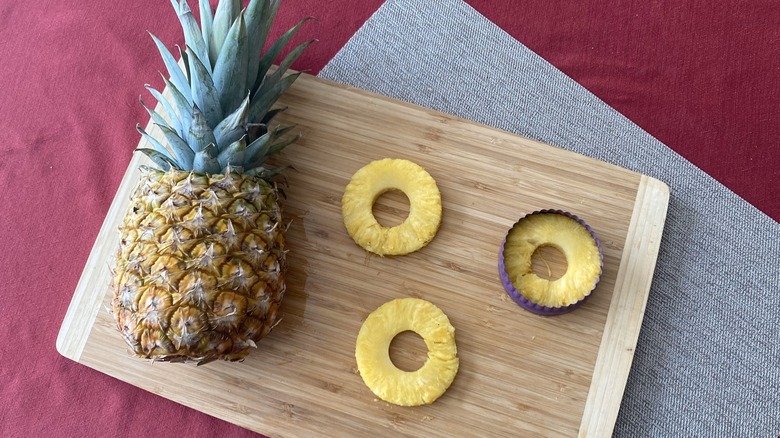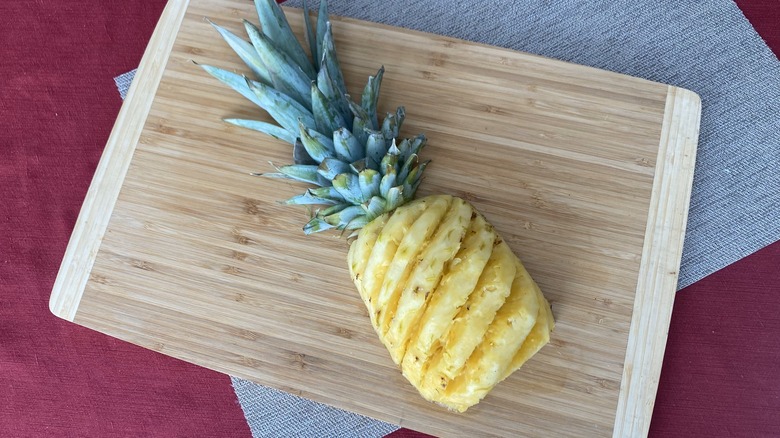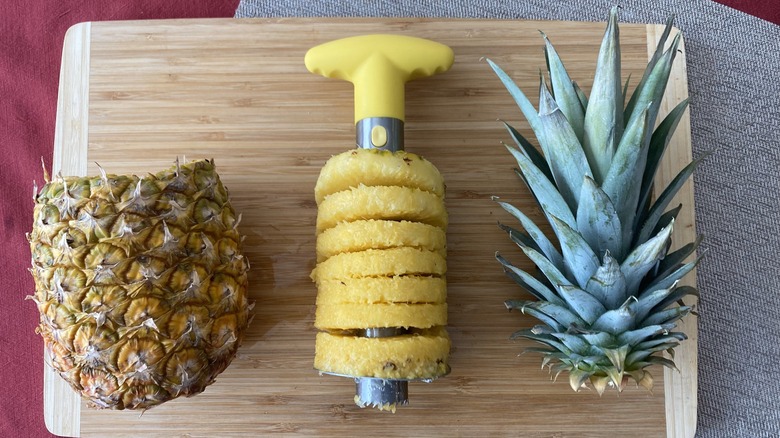10 Pineapple-Cutting Tips And Tricks You'll Wish You Knew Sooner
With their spiky crown and armored skin, pineapples are among the more challenging specimens in the produce world when it comes to slicing and serving. Clever chefs may sidestep working with fresh pineapples in favor of using canned versions, where pineapple occurs in rings, chunks, and crushed form as if it grew that way. But there's nothing like the taste and sweetness of fresh pineapple, used in everything from fruit salad and tropical cocktails to glazed ham and Hawaiian-style pizza (yes, there are plenty of people who love pineapple on their pizza). It's worth knowing how to remove the rind from a whole pineapple so you can enjoy some of the most enticing fruit on earth.
Aside from obvious preparation tips like twisting off the crown to simplify the shape and washing the pineapple to keep from dragging any external dirt or debris through the flesh, there is a host of slick techniques that make easy work of slicing pineapples to achieve a variety of finished forms. We put together a simple guide featuring some of the most helpful tips and tricks that can help you cut to the core of the issue. Even if you're a proven pro at slicing and dicing a world of fruit, you're bound to learn something to take you into the sweet, juicy heart of your own perfectly cut pineapple.
Remove the rind before slicing
Pineapple rind is tougher than just about any other fruit skin you'll encounter. The firm texture and papery flaps can make slicing one a daunting task for cooks who've never tried before. Cutting off the rind before any additional slicing is an easy way to ensure you retain as much flavorful inner flesh as possible. It also helps you to get a clean finished product, free of strange bits that might make for poor presentation as well as make it difficult to chew and enjoy the tender fruit.
Start by slicing off the top and bottom to create clean ends. Then, holding the pineapple upright, slide the blade in from one end, cutting just deep enough to guide your knife between the hard skin and the flesh to separate the two. Once you get going, it should be easy to glide or even saw a bit as you go, trimming connective fibers as the rind comes free. Start again at the top, cutting down and repeating until you've removed all the rind. Depending on the ripeness of your pineapple and the sharpness of your knife, you may need to slice at angles rather than smooth arcs to get your rind removed. Not to worry if it makes your pineapple look a little linear; you can trim away the odd edges to get a rounded shape if that's what you're after. Clean any remaining circular divots by digging them out carefully with a paring knife.
Stand it up on end and slice downward
You may feel a natural tendency to lay your pineapple down when cutting, following a similar approach to slicing melons and other larger pieces of produce. But pineapples are vertical fruit, and standing them on end is your best bet for keeping control of your knife while following the shape's natural contours. Whether you're working to remove the rind or cutting a skinned pineapple into spears, slicing vertically allows you a better vantage to see all sides of the fruit as you cut. To get clean slices, simply hold your pineapple in place on a cutting board, insert the tip of the knife near the center, and drag the blade downward to separate the flesh from the hard inner core. Turn the pineapple and repeat to create slices in the desired thickness, then chop into chunks or mash to make crushed pineapple.
The slick nature of the exposed fruit presents the possibility of your knife sliding around while you work. For safety, you should always make sure the hand that holds the pineapple steady is positioned well behind the knife blade. Pineapples are round and slippery, a double-dose of kitchen trickery that requires slow and steady work with great caution to avoid slips that may result in injury. With a little patience, you can reduce your football-shaped fruit into servable pieces that look good enough to eat.
Use a bread knife instead of a chef's knife
With the tough outer rind covering fibrous interior, it may be easier to use a bread knife instead of the broader blade of a chef's knife to accommodate both textures. You may have a lot of different types of knives to choose from, but the serrated edge of a bread knife is perfect for sawing through the harsh skin that requires a bit of piercing in rougher spots. This is especially true if you intend on leaving the rind on for décor or as an easy grip for wedges and spears. It's also helpful for cutting flat bases and removing crowns while retaining a flat surface to use as a decorative cap for a shelled pineapple filled with fruit.
While the teeth of the bread knife make easy work of tearing through the tough exterior of your pineapple, they may also make it challenging to control your cuts. To ensure accuracy and safety, be sure to keep your free hand clear of the blade. Lay the edge of the knife on the surface of the pineapple and drag back and forth as you apply pressure to break through the surface. Then, adjust the angle of the knife as you cut through to keep your lines straight and your cutting secure.
Remove the core before slicing
Once you've removed the skin, you can make it even easier to get clean slices if you extract the waxy core, or heart, of the pineapple first. This segment is firmer than the rest of the pineapple and can often make enjoying spears or chunks a challenge, similar to chewing woody pulp. It's easy enough to remove by halving your pineapple, then digging out the core by dragging the tip of a chef's knife diagonally into the surrounding fruit and making an angled groove. Cut from end to end, then slide out the core to create clean fruit that's ready for the next cut.
Rather than throwing the core away entirely, you get chef's choice of the sweetest part of the pineapple. Treat yourself by either dragging your knife carefully along the edge to separate any excess flesh surrounding the tough core. Then, enjoy a taste of tangy bliss that only the one lucky enough to conquer the cutting work gets to experience. If there isn't enough attached to cut away, you can also nibble at the core like a corn cob to pull away the sweet fruit.
Slice your pineapple in half first to keep it steady
Cutting half a pineapple is much easier than cutting a whole one, especially if shape isn't a consideration for your finished slices. This will also give you a flat surface to lay your pineapple on a cutting board for further cuts. It's easy enough to create equal halves by cutting off both ends, then inserting the tip of a chef's knife into the center and dragging downward on one side before turning the pineapple and repeating the cut on the other side. Once halved, you can slice out the heart and cut each piece into half-circles with the rind left on for décor. You can also remove the rind and slice each half into quarters, wedges, or chunks.
Half pineapples also make fun themed table toppers that help you serve your finished fruit with island flair. If you're planning on using the hollowed-out husk of your pineapple as a decorative bowl for fruit salad, carefully remove the fruit without damaging the rind by sliding a chef's knife or boning knife between the flesh and the rind and carving it away carefully, similar to hollowing out a watermelon. With a bit of precision, you'll end up with an empty pineapple shell that's ready to party.
Cut on the diagonal following the grooves to create chunk-like sections
Slicing on the diagonal is a super-simple way to create finger-friendly segments instead of the typical chunks, rings, or spears. This method also forgoes skinning the pineapple, making it quicker and less messy to produce edible pieces. Because you'll be cutting through the rind, a bread knife is a better tool than a chef's knife. It's also easier to half your pineapple first and lay each half face-down on your cutting board; this will give you a safe, steady hold as you guide the knife.
Begin by position your knife in the groove that's closest to the end of your pineapple and slice along the line between segments. This will create a shorter cut that produces a diagonal slice. Continue slicing through each groove until you've sliced the entire pineapple half. Then, position your knife crosswise into each intersecting groove and cut across each slice produced by the first set of cuts. This will begin to separate each section, so be ready to hold your pineapple firmly and cut carefully as you go. Once you've completed all cuts, your pineapple half will become mini-spears with a square of rind on top that makes them easy to hold while eating.
Break your pineapple into segments instead of slicing
You may have seen influencers demonstrating a pineapple slicing hack that eliminated the need for a knife while producing bite-sized chunks that practically fall away from the core. This breakaway technique is similar to the diagonal slice, but it can be done much more safely and easily and requires no prior kitchen cutting skills. It also provides a fun party trick that lets guests get in on the juicy fun!
To perform the break-and-take pineapple slicing method, simply remove the crown and tap the bottom of the pineapple on your cutting board several times. Then, roll the pineapple back and forth while pressing down to soften the internal separations and find a tender spot near the end of the pineapple that's riper and more yellow. Sink your thumbnail into the groove between segments and break one off. The first pull may be sloppy, since you're breaking the rind and pushing on the flesh at the same time. But sacrificing the initial segment will loosen the surrounding segments and give you room to work as you separate the rest, one at a time.
Once you get the breakaway started, either continue the process until the pineapple is fully segmented or pass it around the table and let everyone remove their own segments. It can be a bit messy, so be sure to assign someone to clean-up duty.
Use a round cookie cutter to make rings
If you're looking for perfectly circular pineapple rings, why reinvent the wheel when you can put a cookie or biscuit cutter to its intended purpose? This simple tool is ideal for turning out a series of uniform slices that look fantastic dressing up a ham, resting atop an easy-to-make pineapple upside-down cake, or perching coolly on the side of a tiki drink as a groovy garnish.
To make cookie cutter rings, prepare your pineapple by removing the outer rind while keeping the fruit whole. Then, slice your peeled pineapple in even circles, leaving the core in place. Lay each slice flat and press a round cookie or biscuit cutter into the flesh to even out the edges and make a perfectly round pineapple slice. You can remove the core with a paring knife by tracing around the circle at the center of each slice. This eliminates the need for any specialized coring tools that could help you remove the heart before slicing while simplifying your work and producing lovely results.
Carve a decorative double-helix spiral
Transforming a cut pineapple into a carved work of art isn't as challenging as the final results make it appear. You may have seen a pineapple spiralizing hack floating around in your social feeds, executed by kitchen influencers who love to be extra. With a few step-by-step instructions, a sharp blade, and some cautious knifework, you can add a decorative twist that will leave guests scratching their heads, wondering how you did it. Try not to be too impressive with your carving skills, or you might end up being tasked with carving decorative pineapples for everyone else's parties, too!
Prep your pineapple by slicing off the crown and setting it aside so you can use it to decorate the finished piece. Then, remove a thin layer of rind by slicing downward around the exterior of the pineapple. You want to cut through the hard skin but leave the circular divots on the outer surface of the fruit. These will be your guide for the next step. See how they are aligned diagonally? To create the elegant spiral groove, simply take a paring or boning knife, and cut a shallow, angled groove on either side of the divots. Once your slice is complete, remove the thin strip of flesh containing the divots. Continue around the entire pineapple, cleaning up any stray fibers for a more finished look. Or you can do as we did and slice your pineapple in half to produce two carved pieces instead.
Use a coring tool to make coiled slices
Kitchen gearheads may know about a clever implement that lets you get to the heart of your pineapple cutting efforts in the most direct way possible. Coring tools made especially for pineapples are affordable on Amazon and at Walmart, and though they might look like wacky As Seen On TV-style gadgets, they're actually one of the most effective purchases you can make if pineapple slicing is a regular part of your culinary practices. It's as easy as removing the crown, centering the coring tube over the circular pineapple heart, and twisting as you push downward. The blade at the end of the tool will do the slicing for you as you twist. Once your tool hits the bottom, simply pull it back out. You'll have cored and sliced the entire pineapple, leaving a perfectly empty rind intact. There's a button to remove the tool's handle, so you can slide off the circular pieces of fruit and release the core for easier clean-up.
This is the easiest trick by far for slicing pineapple in a single go. The shape of your pineapple determines how smoothly the tool works. If you have a slightly oblong pineapple, you may find the blade slicing through outer rind. This is fine, as long as you weren't planning on using the husk for decorative purposes. Simply slice away any tough pieces that remain on the flesh to clean up your spiral slices, and enjoy a taste of paradise!
